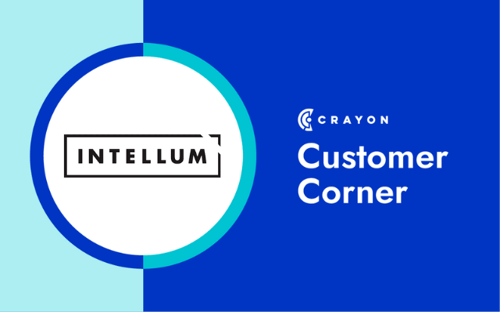Crayon's Competitive Intelligence Spotlight is an interview series where we chat with intelligence professionals to get a glimpse into their careers and gain unique insight into competitive strategy. In this edition of the Competitive Intelligence Spotlight Series, we shine the light on Ben Wunderman, Senior Manager, Competitive Strategy & Marketing at Cruise.
ED: What is your role, and what does your company do?
BW: I manage competitive strategy at Cruise, a leading autonomous vehicle technology company based in San Francisco. I work at the intersection between competitive intelligence, business strategy, and marketing to drive growth and build competitive advantage.
ED: Tell me a little bit about your career. How did you find yourself in the competitive intelligence field?
BW: I joined Lyft, at the time a rapidly growing startup, in 2014. Lyft is now no longer a small startup, and the ridehailing industry has helped drive fundamental change across transportation. I spent time working on operations, launch, and public policy teams at Lyft. However, as the company scaled quickly and our fierce rivalry with Uber intensified, I noticed that we often “explained away” the actions of our larger competitor without trying to understand them in any detail or fully analyze their tactics and product for strategic value. For many of the teams at Lyft, competitive context seemed to be an unaffordable luxury when scaling fast.
To me, this didn’t make much sense—we were pushing hard to innovate and grow but were often undercut by our own thinking or barriers between teams as we all tried to move as fast as possible. After a few false starts, I received the executive support necessary to scale an agile competitive intelligence function at Lyft and got to work making competitive knowledge more reliable, accessible, and useful across the organization.
As I mentioned, Lyft was moving fast in a rapidly developing market, and so our competitive intelligence process had to be even more dynamic to meet the challenges and questions that emerged. I learned many of the key lessons of competitive strategizing in that pressurized environment. Those insights have served me well as I’ve continued to scale and iterate competitive intelligence and strategy functions at other companies and across a broad array of industries.
ED: You’ve spearheaded CI at multiple companies throughout your career. When you’re building out competitive intelligence at a company, what are the first things you put in place?
BW: Contextual understanding must come first. It may sound counterintuitive, but the first thing I do is try and practice “non-doing”. This is a powerful idea that is deeply embedded in classical Chinese strategic thought and it doesn’t mean “doing nothing”. Instead, it is a practical reminder that not taking action is also a strategic move. It is hard to figure out what is really going on if you start acting too quickly. It is even harder to know what tools to use or what processes to build if you don’t know what action should be taken—collecting intelligence just for that sake of it won’t move the needle. You usually only get one chance to be truly “new” to an organization, an industry, a market, or a product. Before I jump in, I like to step back and try to take a broad look at the industry, the company, and the competitive forces at work. Identifying which forces are most important to your company and industry is 90% of competitive strategy. The other 10% is just collecting, analyzing, and disseminating insights that make those forces obvious and developing actionable strategies to use them to drive your business forward.
There is another useful concept in Zen Buddhist practice, shoshin, that refers to maintaining a “beginner’s mind”—coming to an activity with eagerness but also trying to leave as many of your preconceptions behind as possible to enable real learning. There are plenty of useful tools and processes for competitive intelligence, but choosing the tools and processes that will work for your organization is much harder than it may seem. I try to make the most of my “outsider status” before I get caught up in the usual tasks, politics, incentivized goals, personalities, and financial ambitions of the company. I like to take copious notes on the business, its products, and how knowledge is created and shared within and across teams—including the preconceived ideas employees and executives have about the competitive landscape. I then refer back to these notes frequently to ensure that I remain grounded before and after I set up reliable tracking, analysis, and knowledge management tools. After all, the focus of “non-doing” is on creating effective action and the focus of a competitive intelligence manager or strategist should be to create a process of analysis that generates effective action as consistently as possible.
I often feel that pursuing ineffectual action is one of the easiest competitive mistakes to make, especially if you are further from the customer or the core productive activity of the business. It often seems like many businesses produce presentations and emails, but hopefully, there is real value creation in there somewhere! In my view, the businesses that leave the door open for true competitive disruption are usually those businesses that have lost sight of the value that they are really creating. They start managing the value of the process rather than the value of the product. You make a recommendation, the company takes action, and it feels like progress is being made. In reality, those actions that aren’t doing anything at all are the ones that may be damaging your business the most. It is much easier to see the impact of the wrong kind of action than it is to see how actions that have no impact hurt growth, increase costs, and ultimately hand ground to your competitors.
ED: At what stage do you think a company should begin investing in competitive intelligence?
BW: If you are launching a startup or new business—ideally before you do anything else! Incomplete market analysis or ineffectual market entry strategies are often a death sentence for businesses that need to find product/market fit, scale rapidly, and show real progress to investors. There are thousands of startups that have launched products that nobody wanted or that seemed viable on paper. Incomplete market analysis or misleading market intelligence is often the culprit, even if it seems like a customer adoption issue or a problem with market conditions. Markets are dynamic, and when things are constantly changing, you need to keep maintaining dispassionate attention to what is happening outside the narrow context of your business.
There are many in Silicon Valley who still believe a new technology or “perfect product” alone can disrupt huge industries and scale companies. Leveraging network effects and striving for product excellence are absolutely critical for rapid growth, but many industries have now caught up, and dozens of grand ventures have been trapped by an over reliance on product development or a new technological innovation as their competitive moat. Conversely, many large corporations and established businesses have tried to emulate the Silicon Valley approach and end up jettisoning the very elements of brand, manufacturing scale, or distribution that delivered them competitive advantage in the first place! I think it is important to be focused without being reductive.
I believe that the key to long-term competitive success for any company is to embed competitive thinking into the culture of the organization without employees becoming preoccupied with it. It is a very tough thing to do, but I feel that many smart founders and executives are fearful of building an overly competitive culture and end up swinging too far in the opposite direction. By investing wisely in a centralized or reasonably distributed competitive intelligence function, companies can ensure that competitive intelligence informs and drives decisions while teams remain focused.
ED: How do you measure competitive intelligence success?
BW: I’ve explored frameworks that aim to capture the overall financial value of CI to an organization, but I often find that they fall short due to the web of stakeholders who often support and maintain competitive intelligence. Not only that, these frameworks tend to greatly overemphasize cost and financial return at the expense of delivering meaningful business value across the organization. I find it much more useful and impactful to develop OKRs, KPIs, and measurable goals that map to functional areas within the organization that are supported by CI.
Then, benchmark them against your competitive set as thoroughly as possible. For me, that has usually meant being aligned against a range of strategy, marketing, product management, and operational metrics. Showing how your CI efforts have helped deliver 2% market share growth or improved product launch timelines in comparison to key competitors is often far more compelling to your various stakeholders than simply saving money.
ED: What’s the biggest challenge you’ve faced in the CI process?
BW: Getting executive buy-in, without a doubt. Many executives are very competitive but are not particularly interested in competition. They also increasingly enter from an outside leadership role and may not have industry expertise. Getting your executives interested and maintaining their interest over time is a huge challenge and requires a significant amount of trust. Competitive intelligence leaders have to be patient and progressively build trust in small but impactful ways.
ED: What skills do you think are critical for a successful career in competitive intelligence?
BW: Hypervigilance, or as the great Andy Grove would have put it: constant paranoia! Most of us aren’t constantly scanning the environment and tend to fall back on heuristics that allow us to get by pretty well in most situations. I believe this is especially true in business, where frameworks for solving problems are deployed without much consideration. John Boyd’s famous “OODA Loop” is often shown as a balanced cycle of rapid observation, orientation, decision, and action—but Boyd actually put orientation at the heart of the cyclical process. We must constantly reorient ourselves in relation to the market environment, develop new frameworks to understand it, and relentlessly test those frameworks through action. The best competitive intelligence analysts and strategists are those who can rapidly bounce between different (and often conflicting) perspectives.
ED: CI has changed so much over the years, going from strictly manual to automated, and it’s more widely practiced. How do you see CI evolving over the next 5-10 years?
BW: The collection of data that forms the basis of competitive intelligence is indeed becoming more automated, but competitive intelligence is fundamentally an analytical process that is driven by human judgment in the face of uncertainty. Without uncertainty there would be no real need for strategy—it would be clear what to do and we’d all have the same data. If recent months are any indication, the future is no less uncertain than it always has been. However, greater automation in data collection makes the competitive intelligence process easier and allows more time for real analysis. Tech-enabled data collection is invaluable. At the same time, understanding which data are accurate and relevant is now becoming even more critical for managers and strategists. We now have more customer and market data than ever before, but more data does not necessarily mean greater insight. Spinning those data into useful competitive knowledge to drive strategy will not only remain the fundamental goal of competitive intelligence, I think the need for it will increase dramatically over the next decade.
ED: What’s the best career advice you’ve ever received?
BW: Think creatively, cultivate judgment, and question everything.
ED: What’s the best book you’ve read recently?
BW: A fantastic book I frequently go back to is Strategic Conversations: Creating and Directing the Entrepreneurial Workforce by J.C. Spender and Bruce Strong. It’s a practical guide to using the knowledge, initiative, and imagination of your workforce to craft strategy and drive growth.

Related Blog Posts
Popular Posts
-
 The 8 Free Market Research Tools and Resources You Need to Know
The 8 Free Market Research Tools and Resources You Need to Know
-
 24 Questions to Consider for Your Next SWOT Analysis
24 Questions to Consider for Your Next SWOT Analysis
-
 6 Competitive Advantage Examples From the Real World
6 Competitive Advantage Examples From the Real World
-
 How to Measure Product Launch Success: 12 KPIs You Should Be Tracking
How to Measure Product Launch Success: 12 KPIs You Should Be Tracking
-
 How to Create a Competitive Matrix (Step-by-Step Guide With Examples + Free Templates)
How to Create a Competitive Matrix (Step-by-Step Guide With Examples + Free Templates)




